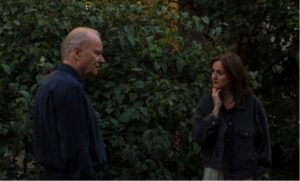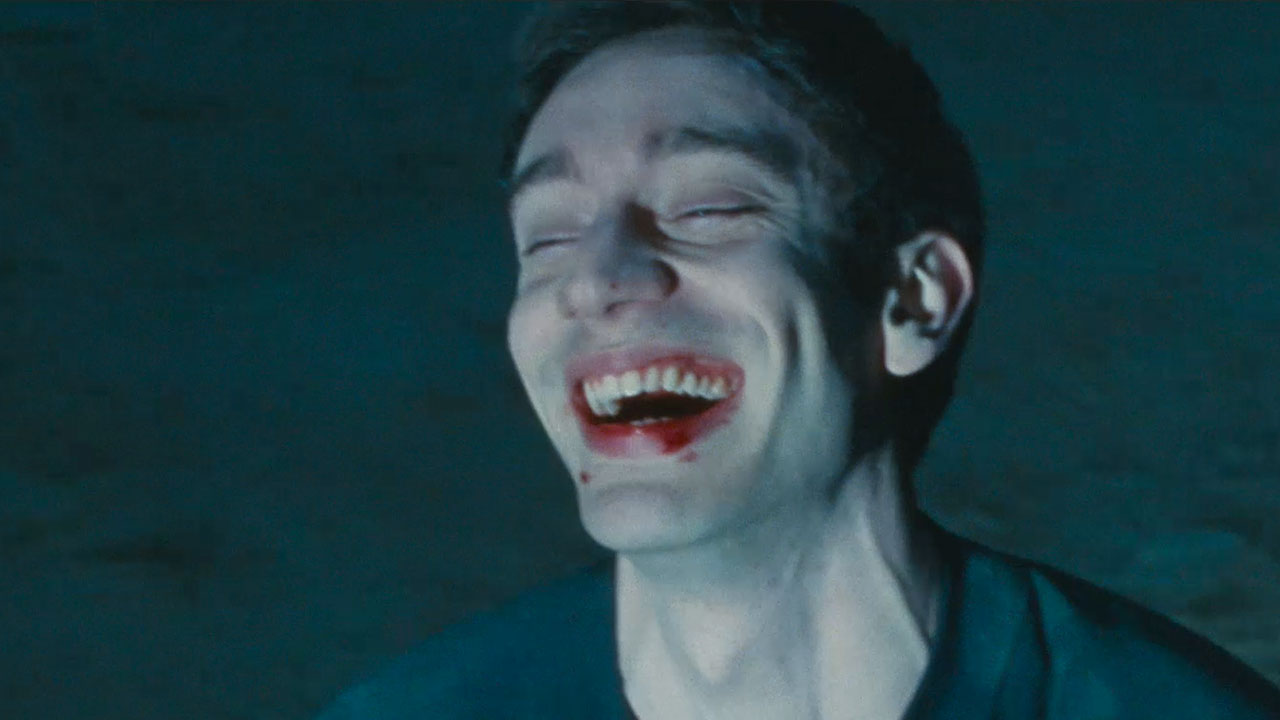Film editor ESMÉ FENICK attends the 69th BFI London Film Festival (8–18 October 2025) to explore the art of discomfort and why it so often makes for great cinema.
Every October, London transforms into a kaleidoscope of cinema – packed screenings, red carpets, frantic rush lines, and a community of filmmakers, critics and cinephiles abuzz with conversation. After two intense weeks of cinematic immersion, I found myself reflecting on all the stories I had encountered, many of them blending in a haze of emotion. Dissecting the feelings they left behind, I noticed the films that stood out were not the polished, traditional crowd pleasers, but those that made me uncomfortable. The ones that unsettled me were the same ones I found myself urging others to see. As Julia Roberts unhinged academic character remarks in Luca Guadagnino’s After the Hunt (2025), “Not everything is supposed to make you feel comfortable.” This sentiment became my unspoken thesis of this year’s festival.
The strange power of discomfort, and why it so often makes for such great cinema, became a central question for me. Scholar Geoff King, in his book The Cinema of Discomfort (2021) explores how audiences are drawn to the uncomfortable: to voyeurism, shame and raw authenticity. These films actively implicate the viewer; rather than remaining a silent spectator, you become part of what you’re witnessing. And perhaps the pleasure lies precisely in that tension – in the discomfort itself.

- Sirat (2025) dir. Oliver Laxe: Visceral and sensorial discomfort
A heavy silence permeated the cinema after Oliver Laxe’s Sirat. In a crowd of press, I expected a wave of chatter or outrage. The first response I heard came from someone who whispered, “I think I hated that.” I felt the same way. I didn’t hate the film – on the contrary, it was the standout of the festival for me – but the experience was so deeply traumatic and frankly unenjoyable that I hated watching it. That is precisely what makes Sirat extraordinary and why I think you need to watch it. As critic Tim Robey warned me, the film contains “one of the most shocking moments” he’s ever seen in a film. I was prepared for shock, but not for the raw, sustained discomfort it provokes.
Set in the liminal vastness of the Moroccan desert, Sirat opens on a techno rave where dancers move freely under the blinding sun and grainy dust. The story follows a Spanish father, Luis (Sergi López), and his young son, Esteban (Bruno Núñez), who are immediately established as outsiders. Luis, disoriented, wanders among drugged ravers searching for his missing daughter, whom he believes has joined the scene.
When the pair meet a group of ravers who claim to have seen her, they embark on a journey with them to the following rave. Despite warnings that their car cannot survive the desert, Luis presses on – an emblem of desperate paternal courage. About an hour in, however, the film undergoes a shocking rupture: a traumatic event of such physical and emotional intensity that it redefines the film itself. Collective gasps filled the cinema. From that point on, Sirat abandons coherent narrative in favour of raw survival and sensorial immediacy. The search for the daughter fades; only the present, the body, and endurance remain.
The film’s soundscape is as vital as its stark imagery. Techno beats merge with desert winds to form a pulsing, uneasy rhythm – a heartbeat of anxiety. Sirat unfolds not through plot but through sensation. As King argues in Cinema of Discomfort, value lies not in narrative resolution but in confronting viewers with ambiguity and unease. Laxe embraces precisely this nihilistic instability.
Do not expect traditional storytelling. Sirat thrives on privileging emotion over entertainment. One raver, played by Jade Oukid, explains that techno music is meant to be danced to, not just heard and likewise, this film is meant to be experienced, not simply watched. The journey moves through waves of hope, dread, shock, and pure discomfort ending in unresolved anxiety that lingers long after the credits roll. Sirat is not “enjoyable” in the conventional sense, but it is unforgettable – a powerful sensorial immersion, fusing sound, image, and raw emotion, and pushing contemporary cinema toward the visceral, disquieting and untraditional.

- Lurker (2025) dir. Alex Russle: The Uncomfortable Obsession with Celebrity
Alex Russell’s debut feature Lurker takes on different modes of discomfort, grounding unease not in violence or horror but in social awkwardness and second-hand embarrassment. As King (2021) suggests, discomfort often emerges from small, humiliating moments; social missteps, silences, and failed emotional gestures that audiences are forced to endure rather than escape. Lurker thrives in this uneasy terrain, offering a darkly comic and painfully familiar portrait of the desperate pursuit of social status – a kind of Gen Z’s Talented Mr. Ripley for the influencer age.
Set against the nostalgic backdrop of Los Angeles’s 2018 music scene, the film follows Oliver (Archie Madekwe), a musician on the brink of stardom, and his circle of parasitic, sycophant friends who feed off his rising celebrity. Within this toxic ecosystem emerges Matthew (Théodore Pellerin), a socially awkward outsider who infiltrates the group through a performance of innocence. His naïveté charms Oliver, and through a series of humiliating, cringe-inducing rituals such as pulling down his trousers, washing dishes and taking out the bins; Matthew somehow earns entry into the inner circle.
Russell satirizes the attention economy and internet-driven celebrity obsession. Tensions rise when Matthew’s friend Jamie (Sunny Suljic) joins the group, provoking jealousy and rivalry that are both viscerally relatable and excruciating to watch. As Matthew’s insecurity festers, he resorts to blackmail to maintain his precarious place in the group. The recurring use of James & Bobby Purify’s “I’m Your Puppet” reinforces the film’s exploration of power and submission as both Matthew and Oliver become figurative puppets, humiliated and ensnared by their own insecurities.
Russell’s storytelling is sharp yet unpretentious, revealing the dangers of fan culture and the romanticised, cut-throat realities of the music industry. Lurker channels almost Shakespearean archetypes of obsession, jealousy, betrayal and morality – extending its critique beyond celebrity culture to the broader human fascination with status and control. As the film gradually morphs into a psychological thriller, Matthew’s façade of fragility gives way to something colder and more deliberate. Pellerin skilfully shifts his eyes from fragile desperation to a darker, more calculating gaze.
Ultimately, the film reflects on the paradoxical human desire both to observe and to be observed. The film concludes with Matthew being celebrated for his documentary and asked by a fan, “What do I have to do to be you?” This question confronts the viewer with an unsettling moral predicament – what are you willing to sacrifice for success?

- Sentimental Value dir. Joachim Trier: Introspective, cathartic discomfort
Contrasting with the other two films explored, Joachim Trier’s Sentimental Value operates on a very different emotional register. Discomfort in cinema is often loud, confrontational, and intense, but this film offers a gentler, slower, and more reflective strain of unease. Much like an intense therapy session that forces you to face emotions you’d rather avoid, it ultimately feels cathartic – leaving you lighter and seeing your family through a more empathetic lens.
The dynamic duo of Trier and his long-time co-writer Eskil Vogt, along with returning actress Renate Reinsve, reunite here. In their widely celebrated earlier work The Worst Person In The World (2021), they dissected a woman’s search for identity and meaning in her 30s through the complexities of love and relationships. Sentimental Value expands that inquiry to the collective, examining the family unit as an ecosystem of inherited emotional baggage. Trier crafts a meditative family drama that unfolds like memory itself: layered, non-linear, and deeply human.
The story centers on two sisters, Nora (Renate Reinsve) and Agnes (Inga Ibsdotter Lilleaas), who are grieving the recent loss of their mother when their estranged father, Gustav (Stellan Skarsgård), suddenly reappears. Gustav, a celebrated filmmaker, is developing a new project and wants his daughter to play the lead. Nora, a successful theatre actress who has never felt acknowledged by her father, immediately rejects the offer without even reading the script. Desperate for the film to be made, Gustav turns to American actress Rachel Kemp (Elle Fanning), an A-lister feeling lost and purposeless in her career. She clings to this project as a chance to rediscover meaning – dyeing her hair brown and learning a Norwegian accent for the role – only to realise that the character she’s embodying needs to be played by Nora herself.
The film within the film explores Gustav’s childhood trauma – his mother’s suicide in the family home. Yet Gustav’s film is less an act of reconciliation than one of emotional translation. Cinema is his only language. Trier uses this as a self-reflective study of how art can both expose and heal but also exploit. Sentimental Value is clearly a film made by and for lovers of cinema – acknowledging how art helps us process pain, even as it sometimes conceals it. One particularly wry moment drew laughter from a press screening when Gustav, in an ill-judged yet oddly tender gesture, gifts his young grandson a box set containing The Piano Teacher (2001) and Irreversible (2002) – a comic nod to the absurdity of cinephiles.
A poignant turning point comes when the sisters finally read Gustav’s script, realising it’s not just about his mother’s suicide but also about Nora’s own depression. Though absent for much of her life, Gustav has nevertheless recognised her pain as the same darkness that once consumed his mother. Nora turns to Agnes to ask why she seems less affected by their shared childhood traumas. Agnes responds, “But we didn’t have the same childhood… I had you.” It’s a simple yet devastating line that captures the profound complexity of family bonds and the ways they shape us.
The family home in Oslo emerges as the film’s true protagonist. Having borne witness to generations of life, births, deaths, marriages, separations, and reconciliations – it is both a domestic space and a cinematic set, a mise en abyme at the heart of the narrative. Under Trier’s direction, the house feels sentient: its walls listen, absorb, and echo. One line captures this beautifully “The house missed the sounds he made”, after their father leaves.
Trier’s characters are raw, imperfect, and deeply human, carrying the universal burdens of familial complexity. The film’s quiet beauty lies in its gentleness, inviting each viewer to confront their own emotional inheritance and find solace in the shared vulnerability onscreen. Ultimately, Gustav’s film is completed, and in the process, the family begins to heal. The final image shows their once-vibrant home sold and remodelled into a sterile, millennial-grey shell of its former self. The trauma has been wiped clean, but so has the life once lived there. It’s an ending simultaneously devastating and necessary, rendered with Trier’s signature poignancy and grace.
Image courtesy of gq.com

